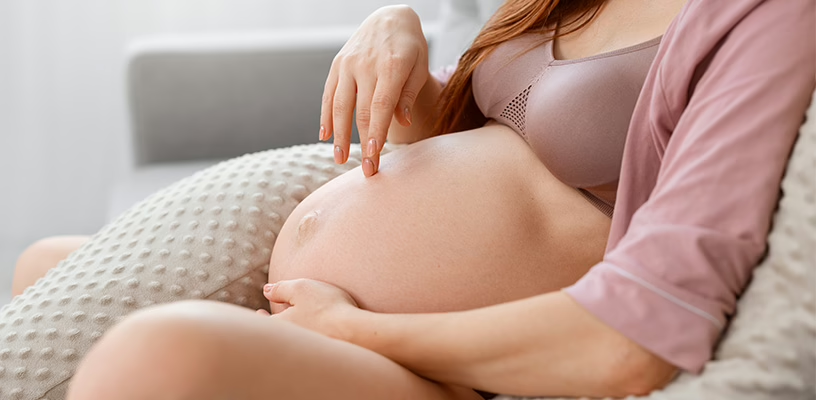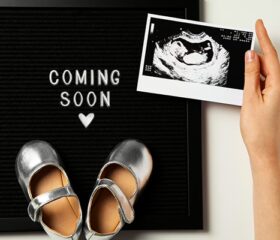Everything You Need to Know About the Second Trimester
Congrats on making it to the second trimester! At this stage, both you and your baby are experiencing many changes.

- When does the second trimester start?
- What key changes will you experience in the second trimester?
- What are the most common second-trimester symptoms?
- What second-trimester symptoms warrant medical attention?
- Your baby’s development in the second trimester
- Your second-trimester checklist
- Final thoughts
Sometimes called the “honeymoon phase” of pregnancy, the second trimester often brings a welcome sense of relief as many of the challenging first-trimester symptoms fade away.
This is when you’re likely to really start showing your pregnancy. Get ready for exciting milestones, such as feeling your baby kicking and finding out her sex. Let’s dive into what you can expect during these transformative months.
What key changes will you experience in the second trimester?
One of the biggest perks of the second trimester is that many of your early pregnancy symptoms will (hopefully) ease up or go away entirely. You’ll probably find this trimester more comfortable than the first.
Here are the key changes to expect as you enter this new stage of pregnancy:
- Decreased nausea: Morning sickness often subsides in this trimester, leading to a better appetite and overall sense of well-being.
- Increased energy: With the decrease in nausea, vomiting, and pregnancy-related fatigue, many women experience a surge in energy during this trimester. You may feel more like yourself and can tackle projects and enjoy activities once again.
- Visible baby bump: As your uterus expands, you’ll notice a more defined baby bump that makes your pregnancy more visible. This is a good time to announce your pregnancy (if you haven’t done so already), especially since the probability of miscarriage drops sharply in this trimester. 3
- Fetal movement: Prepare to feel your baby move for the first time (called quickening). This often takes place when you’re around 19 weeks to 21 weeks pregnant. 4
- New symptoms: While some symptoms will fade, new ones may emerge, such as heartburn, back pain, and leg cramps. We’ll elaborate on them below.
It’s safe to have sex during the second trimester
As some of your first-trimester symptoms subside, you might be more in the mood for sex. It’s generally safe to have sex during pregnancy (at any point), unless your doctor says otherwise or you notice warning signs, such as heavy vaginal bleeding or amniotic fluid leakage. You should, of course, immediately report any symptoms like that to your doctor.
What are the most common second-trimester symptoms?
While the second trimester often brings relief, it also introduces its own set of symptoms.
Here are some common ones to expect and ways to manage them: 1
Heartburn
Although the third trimester is when many women start experiencing heartburn during pregnancy, it can also start earlier, at this stage. It happens when your growing uterus puts pressure on your digestive organs, forcing stomach acid to flow back up your esophagus. This can cause that characteristic burning sensation in your chest and throat. 5
Here are some effective strategies to combat this issue: 5
- Eat smaller, more frequent meals
- Avoid trigger foods like fatty, greasy, or fried foods
- Stay upright for an hour at a minimum after eating
- Wait 2–3 hours after eating before going to bed 6
- Elevate your head with a pillow when sleeping
- Don’t wear tight-fitting clothing
You can also take over-the-counter medications if necessary, but always consult your doctor beforehand.
Back pain
In addition to heartburn, your growing uterus can also lead to lower back pain during your pregnancy. That’s because it shifts your center of gravity and puts strain on your back muscles.
Try these tips to manage back pain in the second trimester: 7
- Maintain good posture
- Wear supportive shoes
- Use a pregnancy pillow while sleeping
- Ease the pain with heat or cold packs
- Practice gentle exercises like prenatal yoga or swimming
- Exercise and stretch regularly
- Bend your knees instead of your waist when picking things from the ground
Lower abdominal pain
Lower abdominal pain, also known as round ligament pain, usually crops up between weeks 18 and 24. 7 Normally, the pain should be mild and last for short periods of time. You can ease the discomfort by moving slowly, changing positions, and wearing a maternity girdle.
Numb or tingling wrists or hands
This numbness and tingling in your wrists and hands is called carpal tunnel syndrome (CTS). Sometimes, you may also feel some weakness and even pain. Pregnant women are more susceptible to getting CTS due to hormonal changes and fluid retention. 8
You can usually get rid of this symptom shortly after giving birth. In the meantime, rest your hands and refrain from making repetitive movements (which can also cause a similar condition called mommy wrist after you give birth).
Your doctor might suggest trying physical therapy, or they may even prescribe medication if the discomfort gets out of hand. 9
Swelling
You can expect some mild swelling in your ankles and feet in your second trimester due to increased build-up of fluid.
The swelling can get quite severe if you develop a form of high blood pressure during pregnancy known as preeclampsia. 10 This pregnancy complication can be dangerous for both you and your baby, so report any extreme swelling (i.e., if you press your skin with your thumb, an indentation remains for a few seconds) to your doctor, especially if it occurs in your face or hands.
Otherwise, if you’re battling swollen feet during your pregnancy, make yourself as comfortable as possible by elevating your feet whenever you can, wearing comfortable shoes, and avoiding standing or sitting for extended periods.
Skin changes
You might notice stretch marks, a dark line down your abdomen, a darkening of the skin near your nipples, and darker patches of skin on your face, called melasma or pregnancy mask. 11
Keep your skin hydrated with moisturizers to help with these skin changes. Additionally, always wear pregnancy-safe sunscreen to protect your skin from further pigmentation changes. These changes typically fade after delivery. 11
What second-trimester symptoms warrant medical attention?
It’s normal to feel mild discomfort during your second trimester, but you should call your doctor immediately if you sense something genuinely wrong, such as if you experience: 1213
- Heavy vaginal bleeding
- Severe abdominal pain
- Fever over 100.4°F
- Sudden weight gain or loss
- Severe swelling in your face and hands
- Changes in vision
- Decreased fetal movement after you’ve started feeling your baby move regularly
Your doctor will probably test you for gestational diabetes at 24–28 weeks. The symptoms of gestational diabetes include extreme thirst and frequent urination, but needing to pee a lot is also a normal pregnancy symptom, so don’t worry if you’re experiencing it. Just keep up with your prenatal visits and get whatever tests your doctor recommends.
Your baby’s development in the second trimester
As your baby enters the second trimester, she probably already has a well-formed face, long and thin limbs, nails on her fingers and toes, tooth buds, and noticeable genitals. 14
During the second trimester, your baby will undergo the following key developments throughout the weeks: 141516
| Week of pregnancy | Size and weight | Key developments |
|---|---|---|
| 14 weeks | - 3.75 inches long - 2 ounces |
- Eyelids are closed and won’t open until around week 28 |
| 16 weeks | - 4.75 inches long - 2.5 ounces |
- Skeleton is hardening - Can hear sounds from the outside (may even respond to loud noises) |
| 18 weeks | - 5.5 inches long - 6.7 ounces |
- You might start feeling your baby’s first movements (quickening) |
| 20 weeks | - 6.46 inches long - 10.58 ounces |
- Probably now has eyebrows and eyelashes - You might be able to hear her heartbeat with a stethoscope - 20-week anatomy scan allows you to confirm her sex (if you choose to find out) |
| 22 weeks | - 10.94 inches long - 15.17 ounces |
- Skin is covered in lanugo (a soft, fine hair that helps regulate your baby’s body temperature) - May have her first bowel movement |
| 24 weeks | - 11.81 inches long - 1.32 pounds |
- Lungs are maturing - Starting to store fat |
| 26 weeks | - 14 inches long - 1.68 pounds |
- Eyebrows and eyes are fully developed - Fingerprints and footprints are forming - May startle upon hearing loud noises |
| 28 weeks | - 14.41 inches long - 1.93 pounds |
- End of second trimester, start of third - Your baby has a good chance of survival if she’s born this week |
Your second-trimester checklist
The second trimester is a good time to prepare for your baby’s arrival—you have more energy and aren’t too pregnant yet. Here’s a checklist to help you stay organized and on track:
Attend your checkups and screenings
Make sure you keep up with your important prenatal appointments and screenings over the next few months. You should:
- Schedule your 20-week anatomy scan: Don’t delay. You should schedule ahead of time, as these appointments can fill up quickly.
- Consider prenatal genetic screening: Explore your options, such as noninvasive prenatal testing (NIPT) or a quad screen, with your doctor.
- Get your glucose screening: This test checks for gestational diabetes, and it’s typically done between 24 weeks and 28 weeks of pregnancy. 17
- Get vaccinated: Doctors recommend that you get the flu shot while pregnant to keep you and your baby safe. 18
Stay comfortable and healthy
Keep yourself healthy and happy by:
- Shopping for maternity clothes: If you haven’t gone shopping for maternity clothes yet, you’d better get started. Find time to load up your wardrobe with comfortable and stylish maternity wear.
- Maintaining a healthy lifestyle: Do suitable exercises regularly and eat a healthy pregnancy diet. Research which nutrient-rich foods best support your baby’s growth and development. Don’t forget to keep taking your prenatal vitamins.
- Avoiding unsafe activities: Don’t engage in activities that put you at risk of falling or abdominal trauma. If you have a cat, you should also avoid handling cat litter when you’re pregnant, due to the risk of a parasite called Toxoplasma.
Prepare for your baby’s arrival
While you still have a few more months to go before you finally meet your baby, there’s no harm in getting organized now. During the second trimester, you should:
- Create a baby registry: Your shopping list is going to get a lot bigger before your baby makes her debut. With that in mind, get your friends and family to help you out by creating your baby registry and sharing it with them.
- Look into childbirth classes: Consider taking a comprehensive childbirth education course to prepare for labor and delivery. While you’re at it, think about your birth plan, including your preferences for labor, delivery, and postpartum care.
- Research childcare options: If you’re planning to go back to work, now is a good time to look into daycare centers, nannies, or family care, especially since a lot of centers can rack up extensive waiting lists.
If you have a newfound boost of energy this trimester, why not consider planning a babymoon? You could check off a bucket list destination or even just book a relaxing hotel closer to home. Take advantage of your free time before you’re juggling dirty diapers!
Final thoughts
The second trimester is an exciting time—your baby is growing quickly and becoming a more noticeable presence. You can feel her little movements and kicks, see her features, and even find out her sex if you like. You’re doing a great job; keep it up!
Article Sources
- Office on Women's Health. "Stages of pregnancy" Retrieved July 15, 2025.
- MedlinePlus. "Prenatal care in your second trimester" Retrieved July 15, 2025.
- UC Davis Health. "Early Pregnancy and Miscarriage Center" Retrieved July 15, 2025.
- MedlinePlus. "Fetal development" Retrieved July 15, 2025.
- Missouri Department of Health and Senior Services. "Relief from Common Problems of Pregnancy" Retrieved July 15, 2025.
- Kaiser Permanente. "GERD: Controlling Heartburn by Changing Your Habits" Retrieved July 15, 2025.
- MedlinePlus. "Aches and pains during pregnancy" Retrieved July 15, 2025.
- MedlinePlus. "Carpal Tunnel Syndrome" Retrieved July 15, 2025.
- Office on Women's Health. "Carpal tunnel syndrome" Retrieved July 15, 2025.
- MedlinePlus. "Foot, leg, and ankle swelling" Retrieved July 15, 2025.
- MedlinePlus. "Melasma" Retrieved July 15, 2025.
- U.S. Centers for Disease Control and Prevention. "Signs and Symptoms of Urgent Maternal Warnings Signs" Retrieved July 15, 2025.
- U.S. Centers for Disease Control and Prevention. "Gestational Diabetes" Retrieved July 15, 2025.
- MedlinePlus. "Fetal development" Retrieved July 15, 2025.
- Louisiana Department of Health. "Stages of Fetal Development - Second Trimester" Retrieved July 15, 2025.
- Louisiana Department of Health. "Stages of Fetal Development - Third Trimester" Retrieved July 15, 2025.
- MedlinePlus. "Glucose screening tests during pregnancy" Retrieved July 15, 2025.
- U.S. Centers for Disease Control and Prevention. "Flu Vaccine Safety and Pregnancy" Retrieved July 15, 2025.







